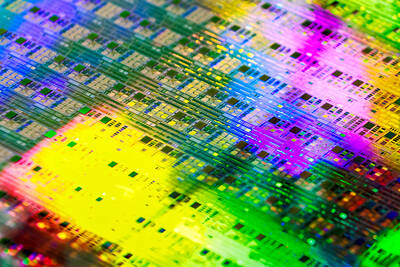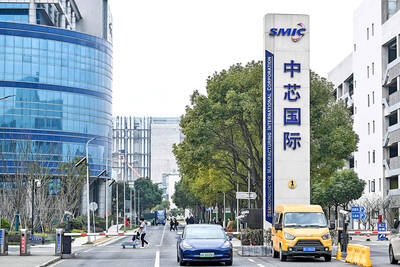Flat-panel display supplier AUO Corp (友達) on Wednesday said it was monitoring the potential fallout from US tariff uncertainty after reporting a profit for the second straight quarter, as customers rebuilt inventory while others pulled in orders ahead of new tariffs.
AUO holds a cautious attitude toward this quarter and visibility for the second half of the year is blurry, as customers are closely watching how the US government’s tariff policy would affect display demand and market consumption, the company said.
“The company had expected the overall market to reach a relatively balanced situation and return to seasonal patterns. However, the tariff uncertainty might have disturbed seasonal demand this year,” AUO chairman Paul Peng (彭双浪) told an online earnings conference.

Photo: CNA
“We have seen some customers’ pull-in demand amid potential fallouts from the US tariff policy,” he said.
As panel displays might become the next item subject to levies under a separate US tariff scheme, AUO is considering working with supply chain partners to come up with plans for manufacturing in regions that have lower tariffs, Peng said.
However, the company is not considering a front-end panel plant in the US due to a lack of panel assembly lines there, he said.
As a panel display and components supplier, AUO expects a mild impact from US tariffs, Peng said.
“About 10 to 15 percent of AUO’s total revenue comes from direct and indirect exposure to the US,” he said, adding that the company is shipping goods on free-on-board terms, meaning that customers would be responsible for duty levies.
The company would closely monitor US tariff developments in the second half of this year and work with customers to adjust manufacturing sites, he said.
AUO president Frank Ko (柯富仁) said the company’s display business last quarter benefited from inventory restocking demand following strong TV sales in the fourth quarter of last year and Chinese subsidies to encourage people to retire old consumer electronics.
The company said the display business in the first quarter performed better than expected, but revenue this quarter is likely to decline slightly due to a higher comparison base.
The display business made up 54 percent of the company’s revenue last quarter.
Its mobility solution business, including displays for auto cockpits, is expected to see revenue drop by a low-single-digit percentage sequentially, the company said.
Revenue from its vertical solution business, including display-related solutions for the retail, medical and industrial segments, is projected to grow by a mid-to-high single-digit percentage, it said.
During the March quarter, AUO’s net profit more than doubled to NT$3.29 billion (US$102.8 million) from NT$1.62 billion the previous quarter. During the same period last year, the company lost NT$3.53 billion.
Operating income improved to NT$1.14 billion last quarter, snapping two quarters of operating losses, while gross margin rose to 12.2 percent, from 7.9 percent in the previous quarter and 3.3 percent in the same period last year, the company said.

NO BREAKTHROUGH? More substantial ‘deliverables,’ such as tariff reductions, would likely be saved for a meeting between Trump and Xi later this year, a trade expert said China launched two probes targeting the US semiconductor sector on Saturday ahead of talks between the two nations in Spain this week on trade, national security and the ownership of social media platform TikTok. China’s Ministry of Commerce announced an anti-dumping investigation into certain analog integrated circuits (ICs) imported from the US. The investigation is to target some commodity interface ICs and gate driver ICs, which are commonly made by US companies such as Texas Instruments Inc and ON Semiconductor Corp. The ministry also announced an anti-discrimination probe into US measures against China’s chip sector. US measures such as export curbs and tariffs

The US on Friday penalized two Chinese firms that acquired US chipmaking equipment for China’s top chipmaker, Semiconductor Manufacturing International Corp (SMIC, 中芯國際), including them among 32 entities that were added to the US Department of Commerce’s restricted trade list, a US government posting showed. Twenty-three of the 32 are in China. GMC Semiconductor Technology (Wuxi) Co (吉姆西半導體科技) and Jicun Semiconductor Technology (Shanghai) Co (吉存半導體科技) were placed on the list, formally known as the Entity List, for acquiring equipment for SMIC Northern Integrated Circuit Manufacturing (Beijing) Corp (中芯北方積體電路) and Semiconductor Manufacturing International (Beijing) Corp (中芯北京), the US Federal Register posting said. The

India’s ban of online money-based games could drive addicts to unregulated apps and offshore platforms that pose new financial and social risks, fantasy-sports gaming experts say. Indian Prime Minister Narendra Modi’s government banned real-money online games late last month, citing financial losses and addiction, leading to a shutdown of many apps offering paid fantasy cricket, rummy and poker games. “Many will move to offshore platforms, because of the addictive nature — they will find alternate means to get that dopamine hit,” said Viren Hemrajani, a Mumbai-based fantasy cricket analyst. “It [also] leads to fraud and scams, because everything is now

MORTGAGE WORRIES: About 34% of respondents to a survey said they would approach multiple lenders to pay for a home, while 29.2% said they would ask family for help New housing projects in Taiwan’s six special municipalities, as well as Hsinchu city and county, are projected to total NT$710.65 billion (US$23.61 billion) in the upcoming fall sales season, a record 30 percent decrease from a year earlier, as tighter mortgage rules prompt developers to pull back, property listing platform 591.com (591新建案) said yesterday. The number of projects has also fallen to 312, a more than 20 percent decrease year-on-year, underscoring weakening sentiment and momentum amid lingering policy and financing headwinds. New Taipei City and Taoyuan bucked the downturn in project value, while Taipei, Hsinchu city and county, Taichung, Tainan and Kaohsiung